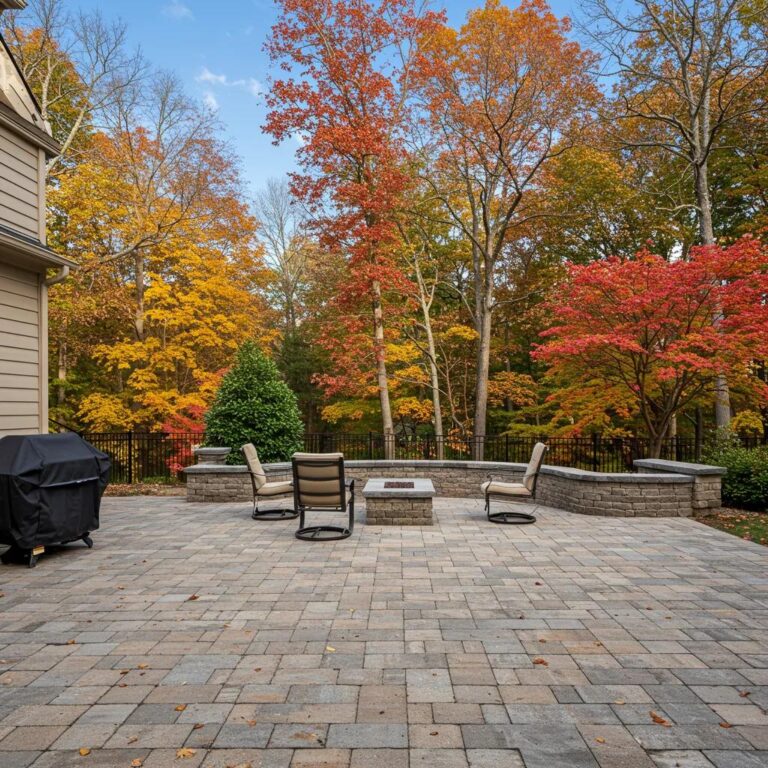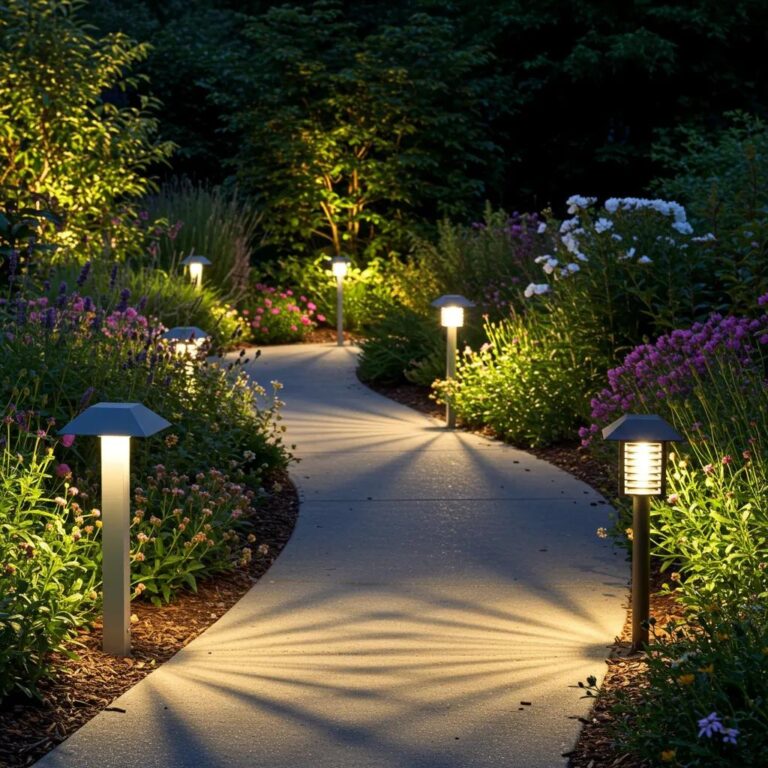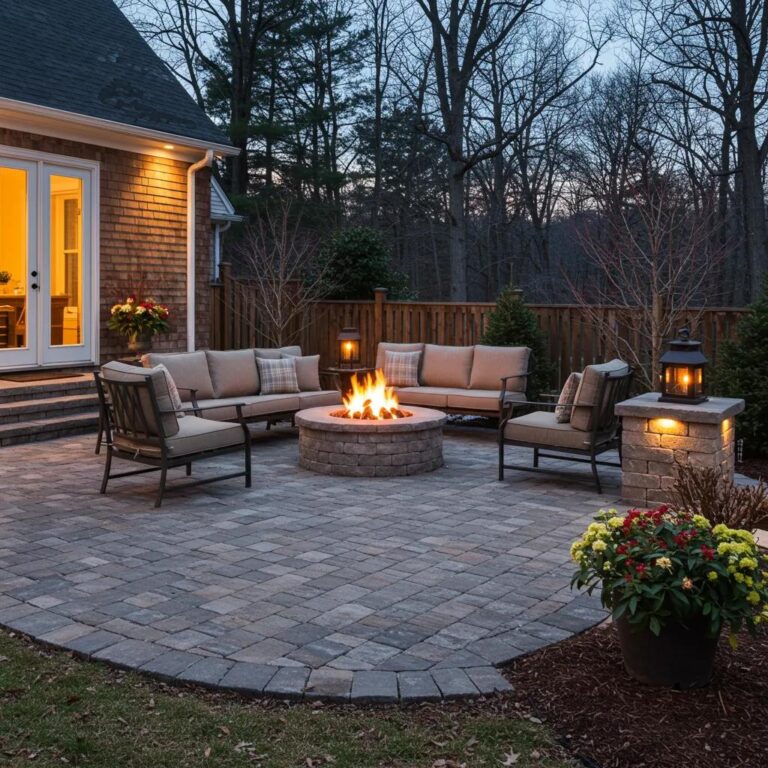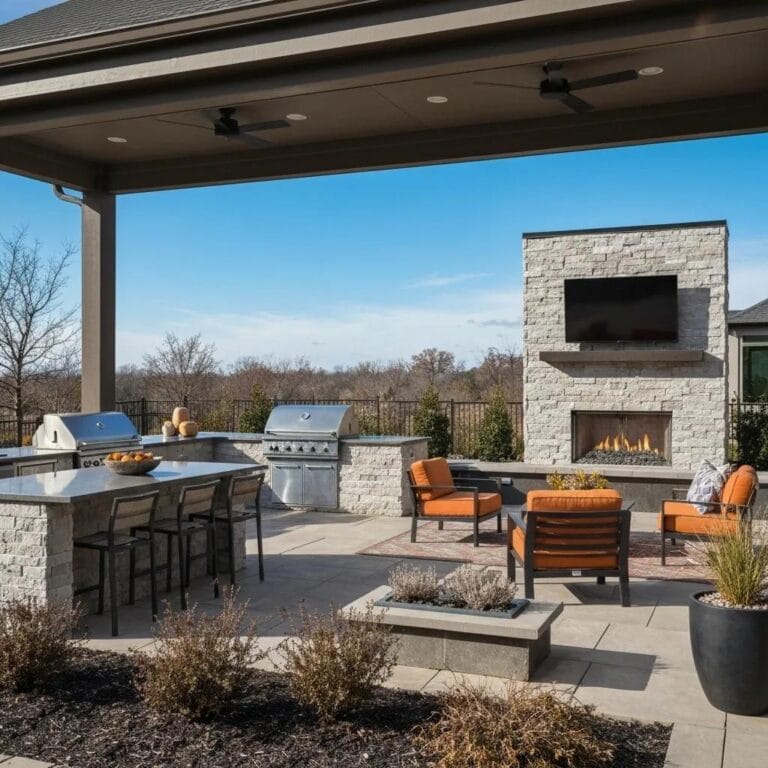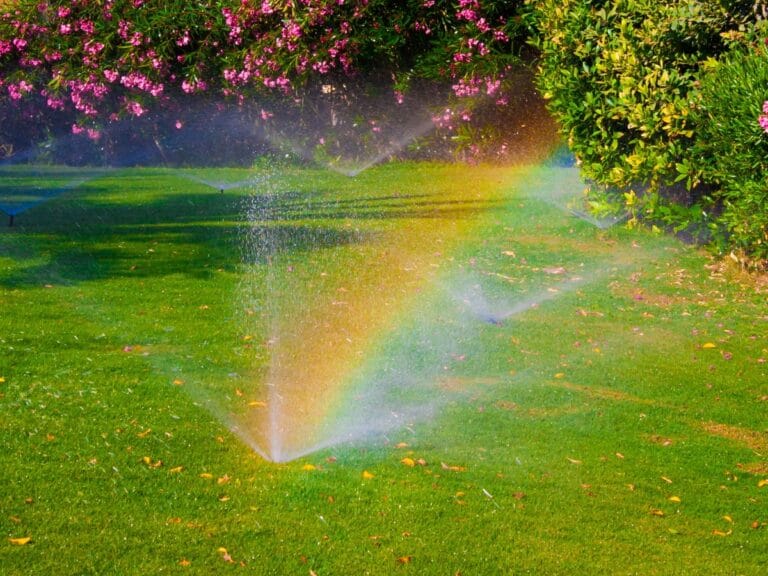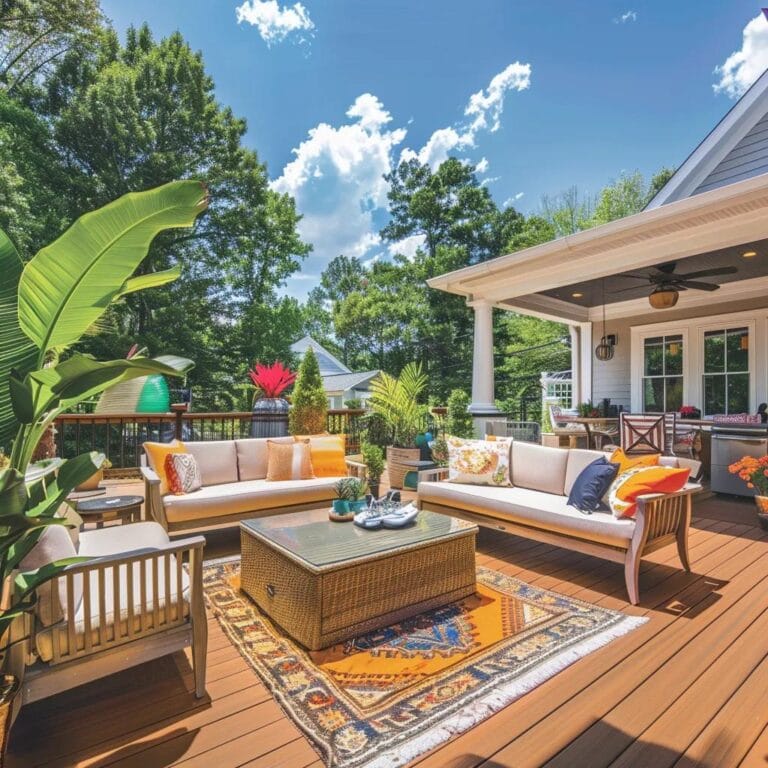Designing a backyard that’s both fun and safe for kids doesn’t mean sacrificing style—especially in Atlanta, where outdoor living is a year-round lifestyle. With thoughtful hardscape features, you can create an inviting, low-maintenance space that encourages play, sparks imagination, and keeps safety a top priority. From smooth paver patios perfect for tricycles to built-in seating walls, shaded pergolas, and splash-friendly surfaces around water features, the possibilities are endless. In this guide, we’ll explore kid-friendly backyard ideas that blend function and fun, helping you craft an outdoor environment the whole family can enjoy for years to come.
Kid-Friendly Backyard Ideas That Spark Endless Fun
Top Hardscape Features to Create Safe, Kid-Friendly Atlanta Backyards
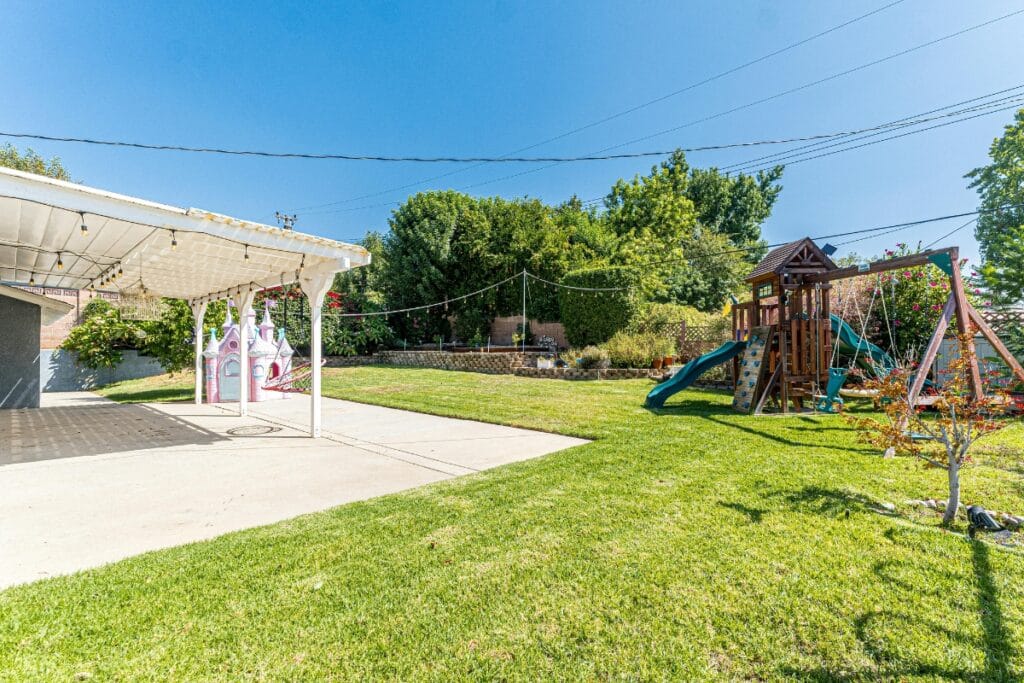
Designing a backyard that’s both fun and safe for kids starts with the right hardscape features. In Atlanta, where summers are hot and the weather can be unpredictable, homeowners need materials and layouts that can hold up over time without sacrificing safety. Features like patios, play zones, and water elements can be customized to fit different yard sizes while keeping children’s needs front and center.
Durable, non-toxic surfaces are key when creating a safe outdoor environment. Textured pavers and decomposed granite are commonly used because they offer stability and help cushion falls. These materials are also low-maintenance, making them a good fit for busy families. Whether it’s a dedicated play space or a multi-use patio, thoughtful planning can help create a space that balances safety, function, and visual appeal.
Which Play Areas Encourage Safe Outdoor Fun?
When setting up a play area, it’s important to consider both safety and variety. Different age groups need different types of play, and a well-planned space can offer options without creating hazards. Surfaces that reduce the impact of trips or falls, such as rubber pavers or compacted granite, are a smart choice for active zones. They hold up well in the Atlanta climate and are easy to clean.
Adding features like swings, climbing elements, and even simple games painted directly on paved surfaces encourages kids to move and explore. For example, a small climbing wall with a shaded cover and a padded surface below lets kids play while staying cool and protected from the sun. Details like chalk-friendly walkways or colorful stepping stones give kids even more ways to use their imagination. Trees, garden beds, and natural barriers can help define zones, offering both shade and a sense of structure.
How Do Water Features Add Fun and Safety?
Water features are a great way to bring sensory play into the backyard while helping kids stay cool during Atlanta’s hotter months. Splash pads, shallow water walls, and motion-activated fountains offer interactive fun without the risks that come with standing water. These elements encourage movement and coordination, keeping kids engaged without needing a pool.
Good design matters. Materials used around water should be slip-resistant, and drainage should be planned carefully to prevent puddles. Choosing shallow features also helps limit safety concerns, while still giving kids a way to play with water. These types of additions can serve as a centerpiece in the backyard while also doubling as a low-risk play option.
What Safety Considerations Are Essential for Hardscape Materials?
Not all materials are suitable for areas where children play. It’s important to pick ones that hold up well in all types of weather and that don’t become slippery when wet. High-traction surfaces like rough-finish pavers or composite decking can help prevent slips. Materials should be free from toxic sealants or chemicals, especially since kids often play close to the ground.
Avoiding sharp corners and uneven surfaces can go a long way in reducing the chance of accidents. Rounded edges on walls or garden borders make play areas safer without sacrificing style. Even after installation, regular checks are helpful for spotting cracks, loose stones, or other issues that might create hazards over time.
How Can You Design a Safe and Engaging Backyard Play Area in Atlanta?
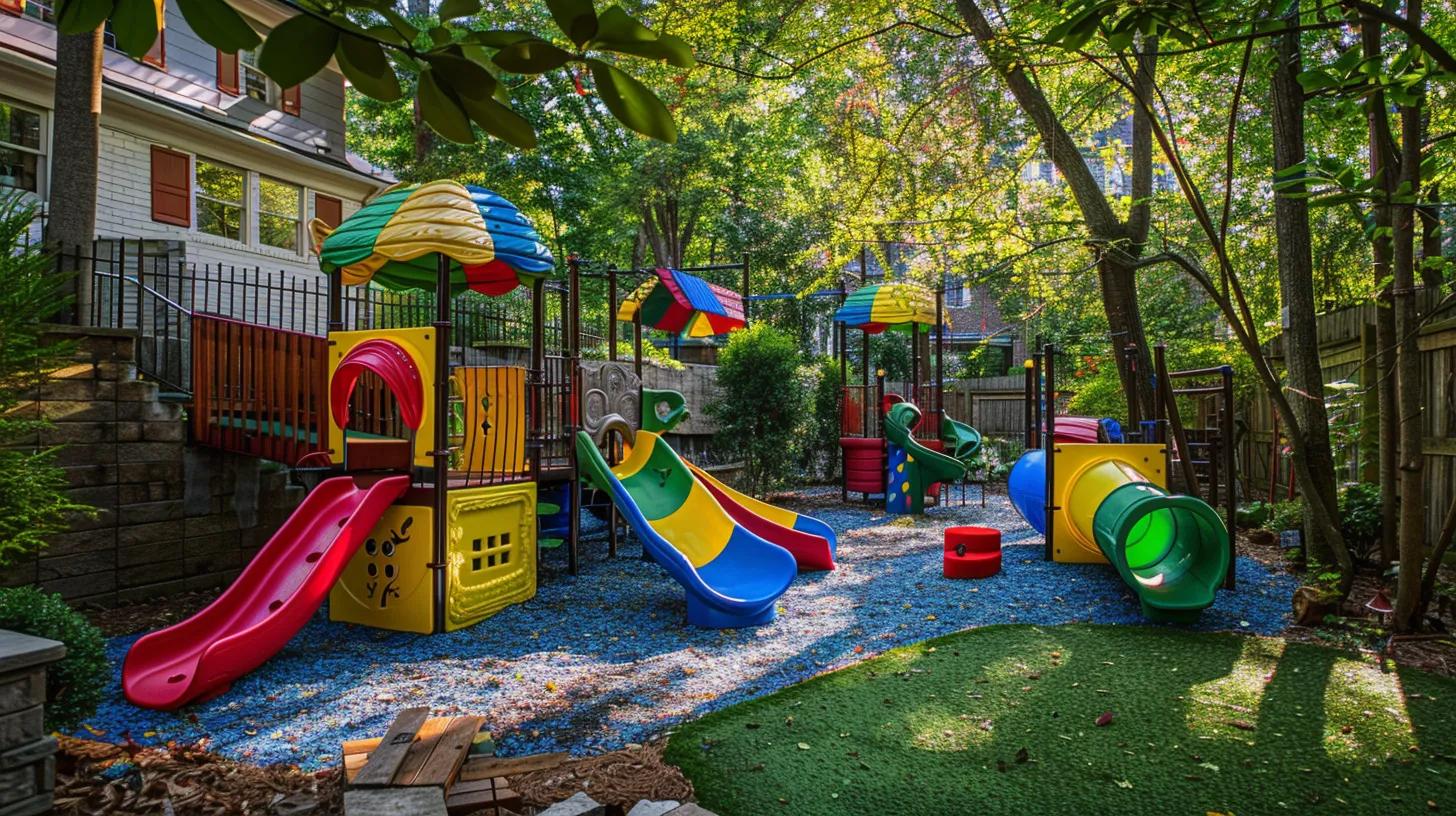
Creating a backyard play area that’s both safe and enjoyable starts with smart planning and an understanding of local environmental conditions. In Atlanta, weather patterns and humidity can affect the performance of outdoor materials, so choosing surfaces and layouts that can handle heat, moisture, and heavy foot traffic is essential.
Safety should always come first. That means selecting shock-absorbing materials, ensuring proper drainage to avoid standing water, and adding barriers or fencing to keep kids within the designated play zone. Parents can feel more at ease knowing the play space is intentionally designed to prevent injuries and allow children to play freely. At the same time, the layout should encourage movement, creativity, and independent exploration, making the space enjoyable for a range of age groups.
What Are Key Safety Standards for Kid-Friendly Hardscapes?
Designing a hardscape that meets safety standards involves more than just soft ground. Surfaces should minimize the risk of injury from falls and be installed in ways that prevent water from pooling. Rubber tiles, decomposed granite, and engineered mulch are all examples of materials commonly used because they offer both durability and shock absorption.
It’s also important that these surfaces are laid evenly and flush with adjacent walkways or structures to avoid trip hazards. Play structures need enough space between them to allow safe movement and prevent collisions. These guidelines, often set by national safety organizations, give a clear framework for building environments that support active play without compromising on safety.
How to Customize Backyard Designs for Different Age Groups?
Children at different stages of development interact with play environments in distinct ways. Toddlers tend to explore close to the ground, so low platforms, soft borders, and rounded edges are more suitable. As children grow, they crave more physical challenges and variety in their surroundings. Structures like climbing walls, balance beams, and tiered decks allow for more dynamic movement while still keeping safety in focus.
The play area can also be designed to grow along with the child. Modular setups or removable panels allow the space to be updated as interests and skill levels change. Thoughtful planning in this area helps ensure the backyard remains relevant and enjoyable over time, rather than something children outgrow quickly.
Which Materials Best Withstand Atlanta’s Climate for Outdoor Play?
Atlanta’s warm, humid climate requires outdoor materials that can handle moisture and temperature shifts without deteriorating. The right materials will not only last longer but also reduce the amount of maintenance needed throughout the year.
Composite decking is a strong choice because it looks like wood but doesn’t absorb moisture or splinter. Decomposed granite is also useful for pathways or surface coverage, offering good drainage and a firm, non-slip texture. Natural stones like slate or granite hold up well under heavy use and resist mold growth, which is a common issue in humid environments.
UV protection is another consideration, especially for plastics or painted surfaces that will be exposed to long periods of direct sunlight. Choosing materials that retain their color and structure through repeated sun exposure can help the area maintain a clean, cared-for look. In the long run, investing in durable, climate-resistant materials saves time and money while making the play space safer and more enjoyable for kids.
What Are Effective Hardscape Solutions for Family-Friendly Outdoor Living?
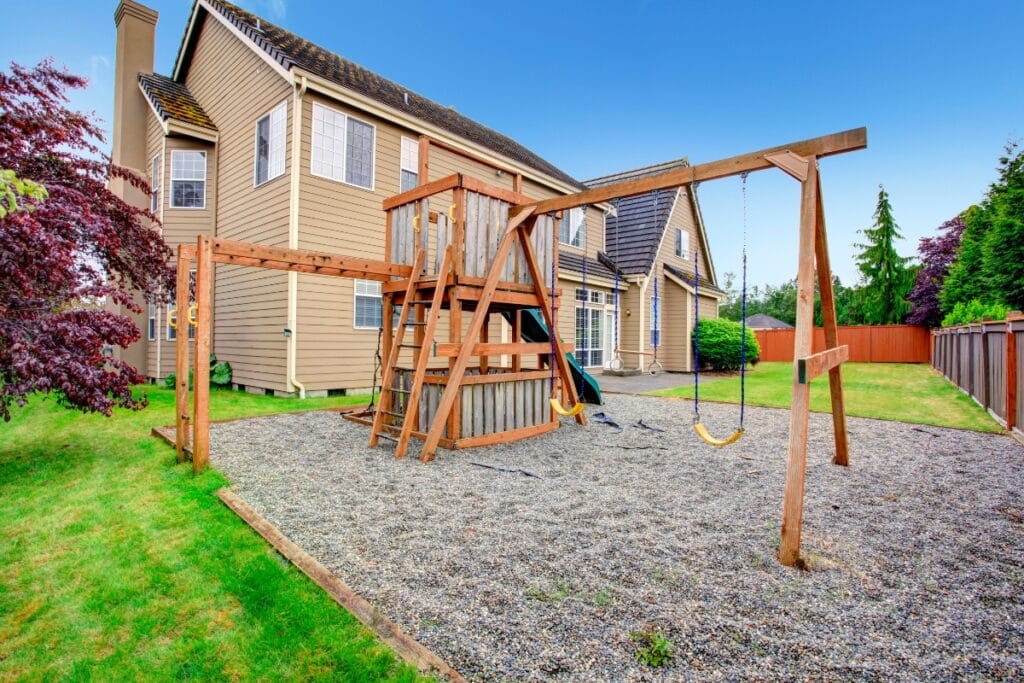
Designing a family-friendly backyard involves more than just adding furniture and grass. The layout and materials used in the hardscape should support both play and relaxation. Patios, walkways, outdoor kitchens, and designated seating areas all contribute to a backyard that works well for families, especially those with children.
When each space is thoughtfully planned, outdoor areas become more than just places to sit or cook. Patios can serve as gathering spots, walkways can guide safe movement across the yard, and kitchens and dining zones can support family meals while keeping children close by. The key is creating a layout that brings together function, safety, and comfort.
How Do Patios and Walkways Enhance Safety and Accessibility?
Safe movement throughout the yard is a major concern, particularly when young children are involved. Well-constructed patios and walkways help define spaces and prevent accidents. Using non-slip materials reduces the risk of slips and falls, even when surfaces are wet. Rounded edges and gradual curves create a softer visual flow while eliminating sharp corners or abrupt turns that can trip up children running or playing.
Lighting also plays an important role. Pathway lights or recessed lighting built into the patio surface make it easier to see obstacles and navigate the space in the evening. Drainage should also be part of the design plan. A walkway or patio that collects water after rain can become a slipping hazard, so proper grading and materials selection are essential for year-round safety.
What Outdoor Kitchen and Dining Features Suit Kid-Friendly Backyards?
Outdoor kitchens and dining areas are popular for entertaining, but they also need to be designed with children in mind. Surfaces should be easy to clean and resist stains from food or drinks. Rounded corners on countertops and built-in seating options reduce risks of injury and limit the need for loose furniture that can become clutter.
Storage is another consideration. Equipment such as grilling tools or propane tanks should be stored safely out of reach. If children are likely to be nearby while food is being prepared, it helps to create a clear separation between cooking areas and play zones. This layout makes it easier for adults to manage meals while still keeping an eye on kids.
A well-designed outdoor dining space can also become a hub for family activities beyond meals, like crafts or board games. By including weather-resistant materials and fixed elements, the area remains functional in different seasons and provides a consistent, usable space for everyone.
How Can Outdoor Storage Improve Backyard Organization and Safety?
A backyard used by children often includes toys, sports equipment, gardening tools, and other items that can quickly become scattered. Without a clear plan for storage, these objects may clutter walkways, collect dirt, or become tripping hazards.
Incorporating built-in storage, such as benches with hidden compartments or low cabinets that blend into the design, helps maintain order. Lockable units are especially useful for storing items that should remain out of children’s hands, like sharp tools or cleaning supplies. The best storage solutions offer both convenience and visual consistency, maintaining the overall appearance of the yard while reducing clutter.
Keeping the yard organized also makes it more inviting. When items are easy to put away and retrieve, the outdoor space remains ready for spontaneous play or family gatherings. Over time, this consistency contributes to a safer and more enjoyable environment.
How Does Fencing and Security Improve Kid Safety in Atlanta Backyards?
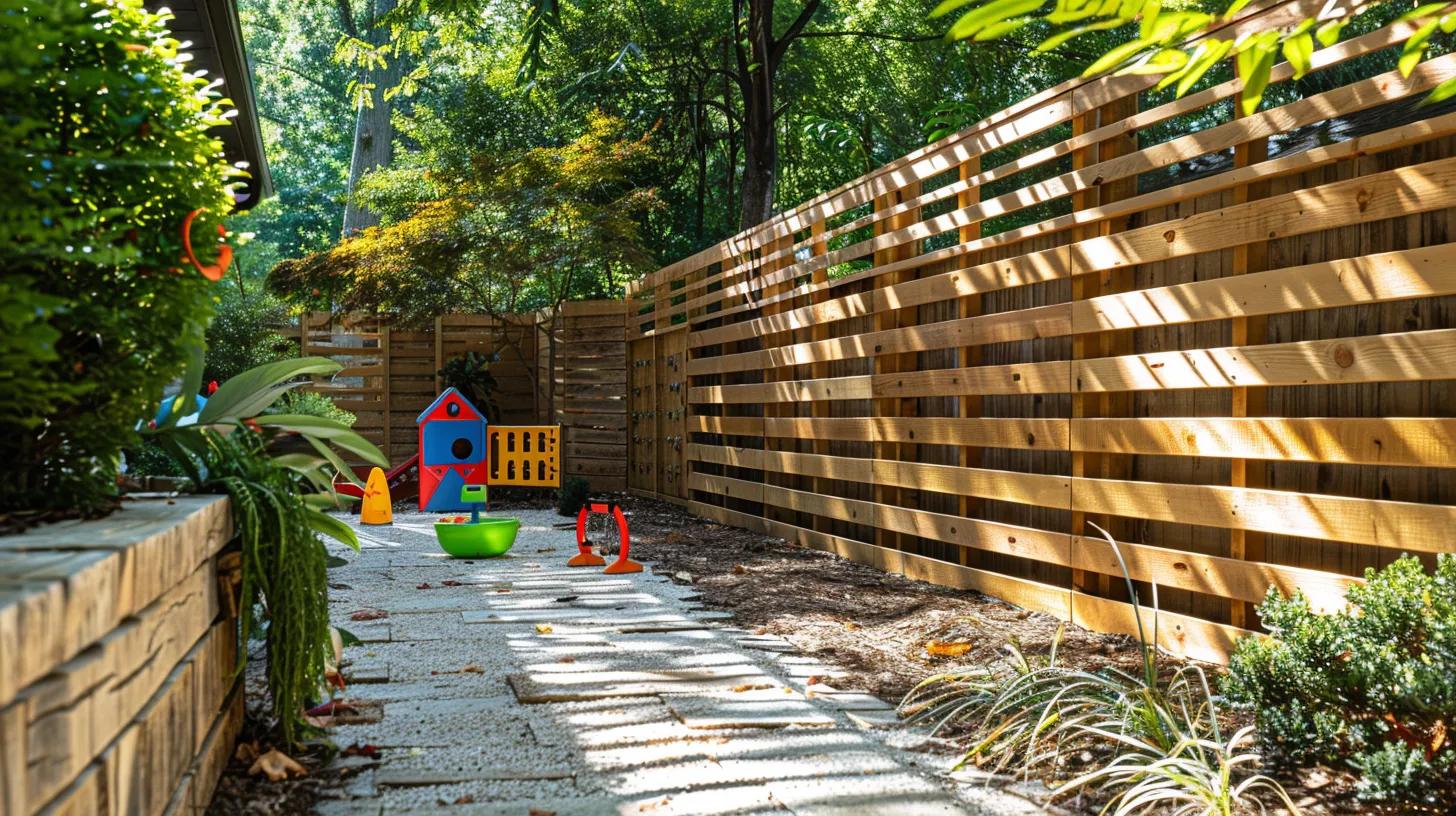
In any family backyard, especially in a busy city like Atlanta, keeping children safe is a top concern. Fencing and basic security measures are essential tools for creating a reliable outdoor space where kids can play without constant worry. A solid fence works as a physical barrier, keeping children within the property and reducing the risk of wandering. It also keeps unwanted visitors or animals out, giving parents more peace of mind.
Security features, when thoughtfully integrated, can further support a safe environment. These may include motion-detecting lights, cameras, and smart locks. Together, fencing and security measures create layers of protection that help families feel confident using their outdoor space daily.
What Types of Fencing Are Best for Child Safety?
When choosing a fence for a backyard that children will regularly use, safety and durability should come first. The material needs to be strong enough to handle wear and tear while also preventing climbing or slipping through. Certain styles, like vinyl and composite fences, provide smooth surfaces and clean lines that reduce injury risks. They are also long-lasting and require less maintenance, which means fewer repairs over time.
Wrought iron, on the other hand, offers a more traditional and durable option. While it has open sections, the spacing between bars can be customized to prevent children from getting stuck or squeezing through. For families seeking a balance between strength and appearance, custom fencing can address specific needs such as height, gate placement, and visibility. The goal is to create a barrier that is both functional and visually appropriate for the home.
How to Integrate Security Features Without Sacrificing Aesthetics?
Adding security to a backyard doesn’t mean giving it a cold or institutional feel. It’s possible to include helpful security features while maintaining a pleasant, welcoming space. Low-profile lighting, for example, improves visibility at night without being harsh. Strategically placed lights along the fence can highlight pathways and corners while also acting as a deterrent to unwanted activity.
Motion-sensor lighting near gates and entrances offers added protection. These lights remain off until movement is detected, helping to conserve energy while still serving a practical purpose. Some families also use small, wireless security cameras that blend into existing landscaping or are mounted on fencing in a way that doesn’t draw attention. These cameras can be monitored from a phone or tablet, providing quick access to the property’s view at any time.
Plantings can also play a role in both privacy and appearance. Tall hedges or climbing plants along a fence offer visual coverage while softening the hard lines of a barrier. They provide natural shade and improve the look of the fence line, creating a more relaxed and family-friendly atmosphere. These additions are particularly useful in homes where the backyard is used regularly for both play and entertaining.
A well-designed gate also contributes to safety and design. Gates should have secure latching systems that are out of reach for small children but easy for adults to use. Choosing a gate style that matches the rest of the fence and home keeps the overall appearance cohesive.
What Are the Top Tips for Maintaining Kid-Friendly Hardscape Features Year-Round?
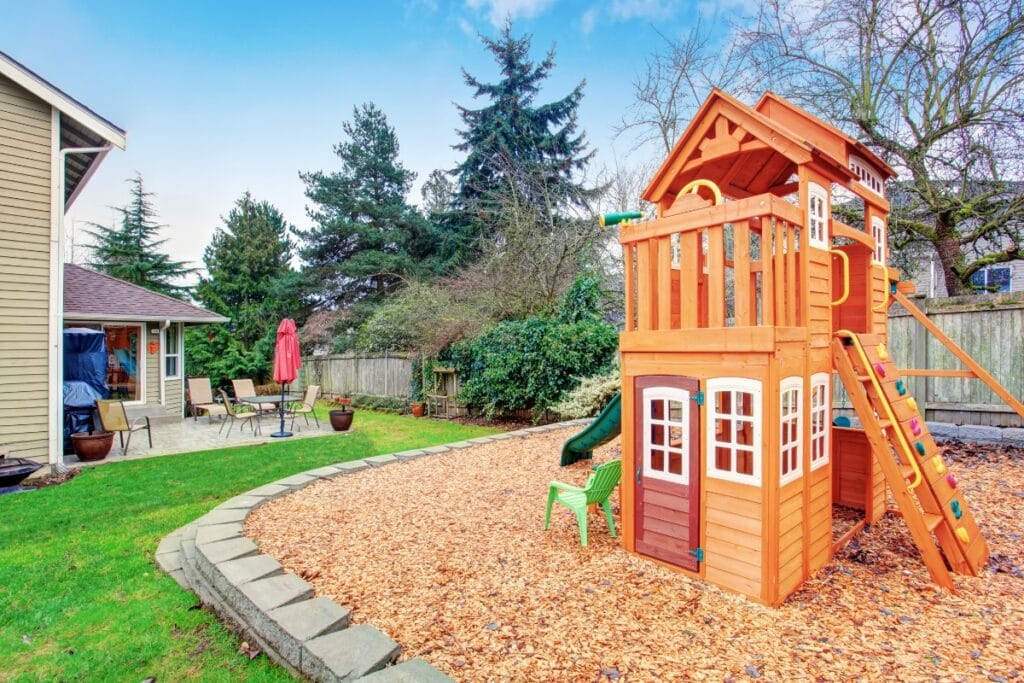
Keeping hardscape features in good condition throughout the year is essential for both safety and visual appeal. In Atlanta, the changing weather—ranging from hot, humid summers to sudden cold snaps—can wear down even the best-built outdoor spaces. To ensure kids have a safe and enjoyable place to play, regular maintenance and smart planning go a long way.
The key is to stay ahead of wear and tear. Surfaces like patios, play areas, and walkways need regular upkeep to avoid becoming slick, cracked, or unstable. With the right materials, tools, and maintenance habits, homeowners can extend the life of their outdoor areas while giving kids a dependable place to explore and play.
How to Protect Hardscape Features From Atlanta Weather?
Atlanta’s weather can be unpredictable, with strong sun, heavy rain, and occasional freezes. Each of these conditions can impact outdoor surfaces in different ways. Sun exposure can fade color and weaken sealants. Moisture can seep into cracks, causing materials to shift or degrade over time. Freezing temperatures may expand those cracks, leading to larger structural issues.
To protect against these problems, it’s important to use materials designed to handle moisture and sunlight. Applying a weather-resistant sealant helps prevent water damage and fading. These sealants often need to be reapplied every couple of years, depending on the level of use and exposure. A slightly sloped patio design helps water drain away, reducing the chance of puddles forming and creating slick spots.
Routine cleaning also plays a role. Leaves, dirt, and standing water can all cause surface stains and create slippery areas. Regular sweeping and occasional rinsing help keep surfaces clean and safer for play. If mold or algae start to form, spot-treating with a gentle cleaner can restore both traction and appearance.
When Should You Inspect and Repair Play Areas for Safety?
It’s easy to assume that once a hardscape is installed, it’s good to go for the long term. But like anything outdoors, it needs regular inspection. A quick walk-through every season helps catch early signs of damage, such as loose stones, cracks, or shifting borders. It’s also smart to inspect the area after major weather events, like heavy rain or sudden freezes, since these conditions can create hazards.
A written maintenance log can help track when inspections take place and what issues were found. This approach is especially useful for families with busy schedules, helping make sure that safety doesn’t slip through the cracks. Addressing small problems early—like re-leveling a loose paver or filling in a crack—can prevent more serious issues down the line.
What Are Cost-Effective Maintenance Solutions for Busy Families?
Maintaining a kid-friendly backyard doesn’t have to be time-consuming or expensive. Choosing durable materials up front often leads to fewer problems later. Composite decking, weather-tolerant pavers, and properly treated wood can all cut down on the need for frequent repairs.
For families juggling work, school, and activities, keeping maintenance simple is key. Multi-purpose sealants that protect against both UV rays and moisture help reduce the number of upkeep tasks. Basic home repair kits can take care of small fixes without having to wait for outside help.
Scheduling a seasonal checkup with a local pro can also be worthwhile. Even if most of the upkeep is done at home, a quick professional look once a year can spot developing problems early. This approach saves money in the long run and keeps the space safe and ready for use.
How Can Atlanta Homeowners Maximize Backyard Fun While Ensuring Safety?

A well-planned backyard can serve as a space for both high-energy play and quiet family time. In Atlanta, where outdoor living is a year-round possibility, homeowners have an opportunity to create environments that support a range of activities. The key is to design a space that balances movement with comfort, encouraging kids to stay active while giving adults a chance to relax nearby.
By dividing the yard into functional zones, families can make the most of the available space. Whether the goal is imaginative play, outdoor dining, or unwinding in the shade, thoughtful design makes it possible to blend those priorities without compromising safety or style.
What Are Creative Ideas for Combining Play and Relaxation Spaces?
One approach to combining play with relaxation is to create shared-use areas that can shift with the day’s needs. A patio might include a built-in picnic table that doubles as a crafting station or board game surface. Placing benches along walkways helps define the space and gives caregivers a comfortable spot to supervise nearby play zones.
Play structures don’t have to dominate the yard. Instead, small climbing elements or stepping paths can be tucked into the landscape. A corner with a low pergola and cushioned seating can serve as a reading nook while remaining in view of the main play area. Using modular outdoor furniture gives the space added flexibility. Chairs and tables can be rearranged for different purposes, from birthday parties to quiet dinners.
How to Encourage Active Play With Hardscape Features
Encouraging movement doesn’t require large installations. Hardscape features like wide stepping stones, ground-level balance beams, or gentle slopes can become part of a game without standing out as obvious play equipment. Painted surfaces for hopscotch or four-square add variety and promote coordination. Some families even add chalkboard walls or spaces for sidewalk chalk drawings directly onto textured pavers.
Incorporating these elements into the design rather than adding them later creates a more unified look. Using durable materials such as decomposed granite or concrete with a textured finish makes the space safer by providing traction and resisting wear. Low-maintenance materials also allow more time for enjoying the yard and less time repairing it.
A few designs even include small tech features, like QR codes embedded in stepping stones that link to scavenger hunts or activity prompts. This can give children new ways to explore the yard while incorporating learning and play.
What Role Do Landscaping Elements Play in Kid-Friendly Hardscapes?
Landscaping contributes more than just visual appeal. Carefully chosen plants and natural features help define activity zones and improve safety. Strategically planted trees can offer shade without obstructing sightlines. Shrubs and flower beds create gentle barriers that guide foot traffic and keep kids from running into less safe areas.
Raised garden beds encourage children to take part in gardening while also creating clear boundaries. Rock features or short retaining walls can serve as low climbing challenges or simply help divide space without using fencing.
Choosing native plants adds another layer of interest. Local flowers and trees that attract butterflies or bees offer a chance for kids to observe nature up close. In this way, the landscape becomes part of the play experience, adding an educational component to the environment.
Natural materials can also be used to reduce risks. For example, using mulch or bark chips around trees softens falls and keeps roots protected. Sloped areas can be planted with ground cover to prevent erosion while also discouraging rough play in those zones.
Where Can You Find Expert Kid-Friendly Hardscape Design Services in Atlanta?
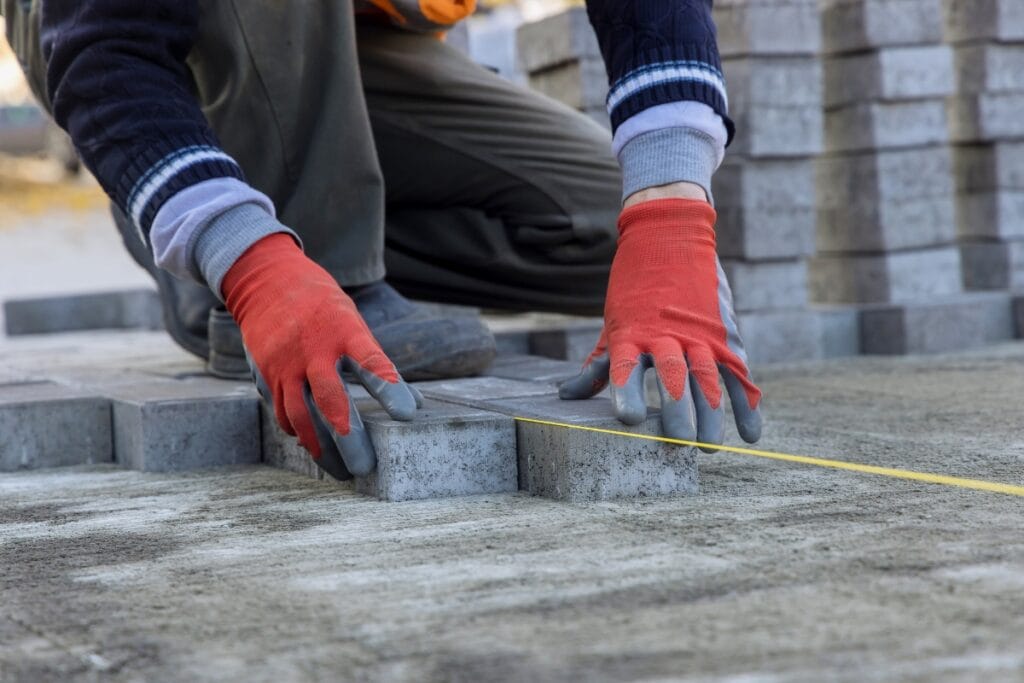
Creating a backyard that balances play, safety, and visual appeal requires thoughtful planning and an understanding of how children interact with outdoor spaces. In Atlanta, where the weather ranges from hot summers to rainy seasons, choosing the right hardscape layout and materials is especially important. Professionals who specialize in family-focused outdoor design understand these challenges and work to build environments that meet both the practical needs of parents and the energy of kids.
A successful kid-friendly hardscape is more than just installing a playset or patio. It’s about making sure that surfaces are safe to run on, shaded areas are available, and there’s enough space for everyone to enjoy the yard comfortably. Finding a designer who understands how to tie all these features together is a big step toward building a backyard that your family can use year-round.
What Should You Look for in a Kid-Friendly Backyard Designer?
When choosing a backyard designer in Atlanta, it’s helpful to look beyond general landscaping experience. A designer who has worked on family-oriented spaces will understand how to include child-focused features without compromising the overall design. They should be able to show past projects that balance function and aesthetics while addressing common safety concerns.
Clear communication is also key. Look for someone who can explain their process, provide a realistic timeline, and offer a detailed estimate before any work begins. A good designer will factor in local safety codes, recommend age-appropriate features, and suggest materials that won’t require constant upkeep. Their understanding of how children use space—where they tend to run, climb, or rest—can shape a design that is not only fun but also practical and safe.
How Does Local Climate Knowledge Improve Backyard Hardscape Longevity?
Atlanta’s weather presents unique challenges. Hot summers, high humidity, and the occasional storm mean that materials need to be both durable and weather-resistant. Local designers know which products hold up best under these conditions. They may recommend UV-resistant composite decking that won’t splinter, or textured pavers that provide traction even when wet.
Drainage is another factor that can’t be overlooked. Poorly managed water runoff can make surfaces slippery or cause long-term damage. Designers familiar with the area will build in drainage systems that work with Atlanta’s rainfall patterns, helping preserve your investment and prevent unexpected maintenance costs.
The benefit of this local knowledge is not just about preventing problems but also about reducing the need for constant repairs. Choosing the right materials and design from the start can keep the space looking and functioning well for years, saving time and money over the long run.
What Are Typical Project Timelines and Budgets for Kid-Friendly Hardscapes?
The timeline for designing and installing a kid-friendly hardscape varies based on the size and complexity of the project. In general, a moderate project might take anywhere from three to six months, starting from the initial consultation to the final walkthrough. More intricate designs or those requiring permits may extend that timeline.
Costs can also vary widely. A smaller-scale project with simple features may fall under $15,000, while more complex builds with custom materials, multiple zones, and built-in safety features can range closer to $35,000 or more. The important thing is to get a clear breakdown of costs early in the process. A well-organized plan that outlines each phase helps avoid delays and keeps expectations realistic.
Frequently Asked Questions
Q: What are the most important hardscape features to consider for a kid-friendly backyard? A: Prioritize safe play areas with impact-absorbing surfaces, accessible patios, secure walkways, and exciting water features. Every feature should adhere to safety standards with rounded edges and non-slip finishes to ensure durability against Atlanta’s challenging weather.
Q: How often should I inspect and maintain my backyardhardscape surfaces? A: It is best to inspect the surfaces quarterly and immediately after severe weather events to catch any cracks, wear, or drainage issues early. Annual professional inspections provide extra reassurance and help guide necessary repairs.
Q: Which materials are best suited for outdoor play areas in Atlanta? A: High-quality natural stone, composite decking, textured pavers, and UV-resistant sealants excel in Atlanta’s climate. These materials provide durability, slip resistance, and low maintenance while keeping the play area visually appealing.
Q: Can I integrate outdoor kitchen and dining areas into a kid-friendly backyard? A: Yes, incorporating outdoor kitchen and dining areas enhances overall backyard functionality. Ensure the design features rounded countertops, secure storage, and non-slip surfaces to safely separate play areas from cooking zones.
Q: What type of fencingis recommended for family-friendly outdoor safety? A: Opt for sturdy fences made from vinyl, composite, or wrought iron. These materials create strong physical barriers, come with secure locks and smooth finishes, and can be designed to harmonize with the overall landscape.
Q: How can a professional hardscape designer help with backyardsafety? A: A designer brings expertise in selecting materials, integrating safety features, and creating custom layouts that meet local climate challenges. Their holistic approach ensures that every component works together to form a secure and engaging space.
Q: Are there eco-friendly options available for kid-friendly hardscape designs? A: Yes, eco-friendly options include using recycled materials for pavers, sustainably sourced composite decking, and natural stone. Native landscaping and water-efficient irrigation systems further enhance sustainability and functionality.
Final Thoughts
With thoughtful hardscape features—like smooth-surface paver pathways, built-in seating walls, and gentle play zones—you can transform your backyard into a vibrant, secure playground that sparks imagination and keeps little adventurers safe with professional hardscaping services. From colorful stepping stones to rock-bordered garden beds, each element balances durability with child-friendly backyard design for endless hours of outdoor fun. Ready to create a backyard that both you and your kids will love? Reach out to Atlanta Hardscape Kings at (470) 606-7895, or fill out the form on our website for a free estimate, and let’s build your family’s new favorite hangout!
